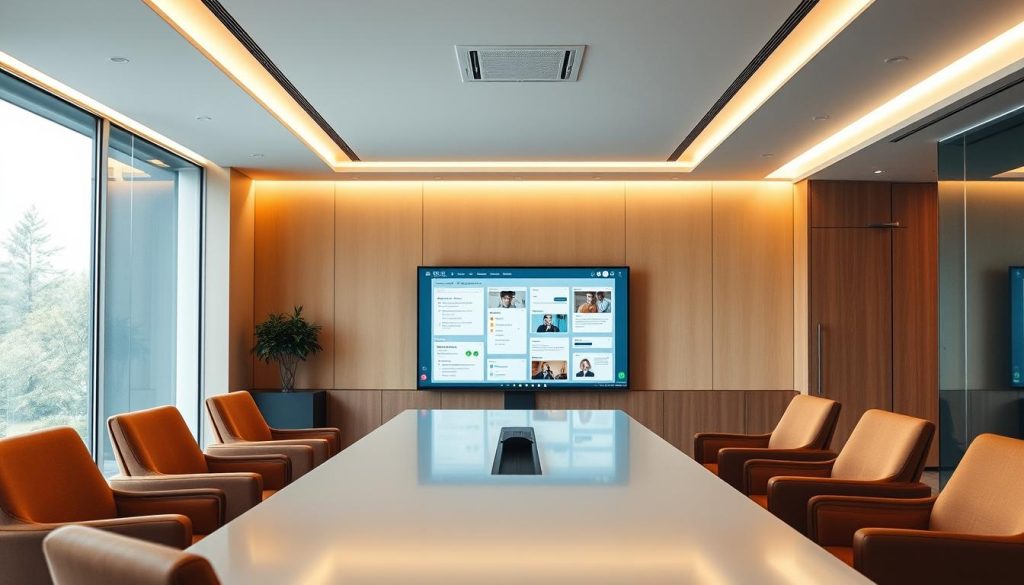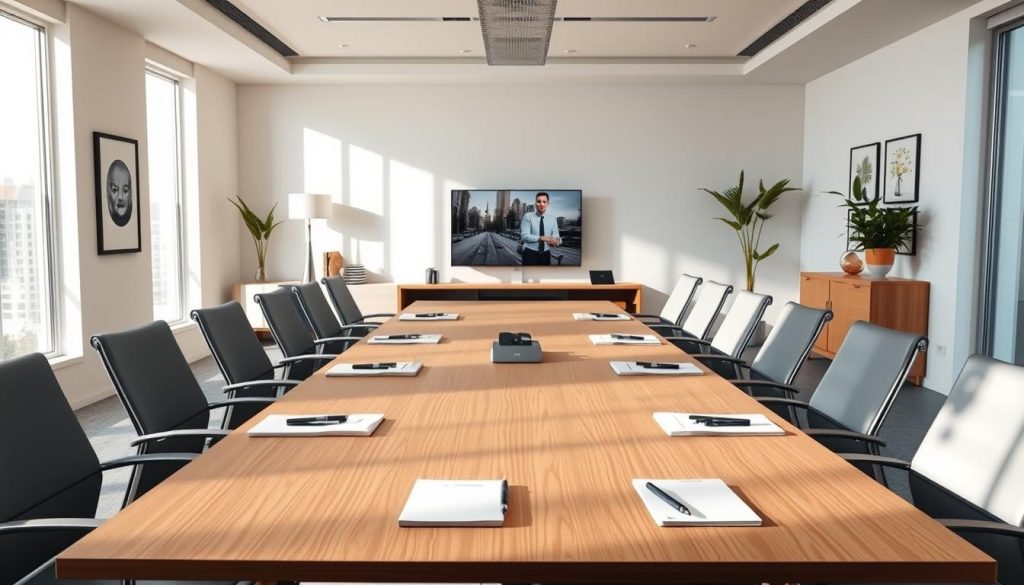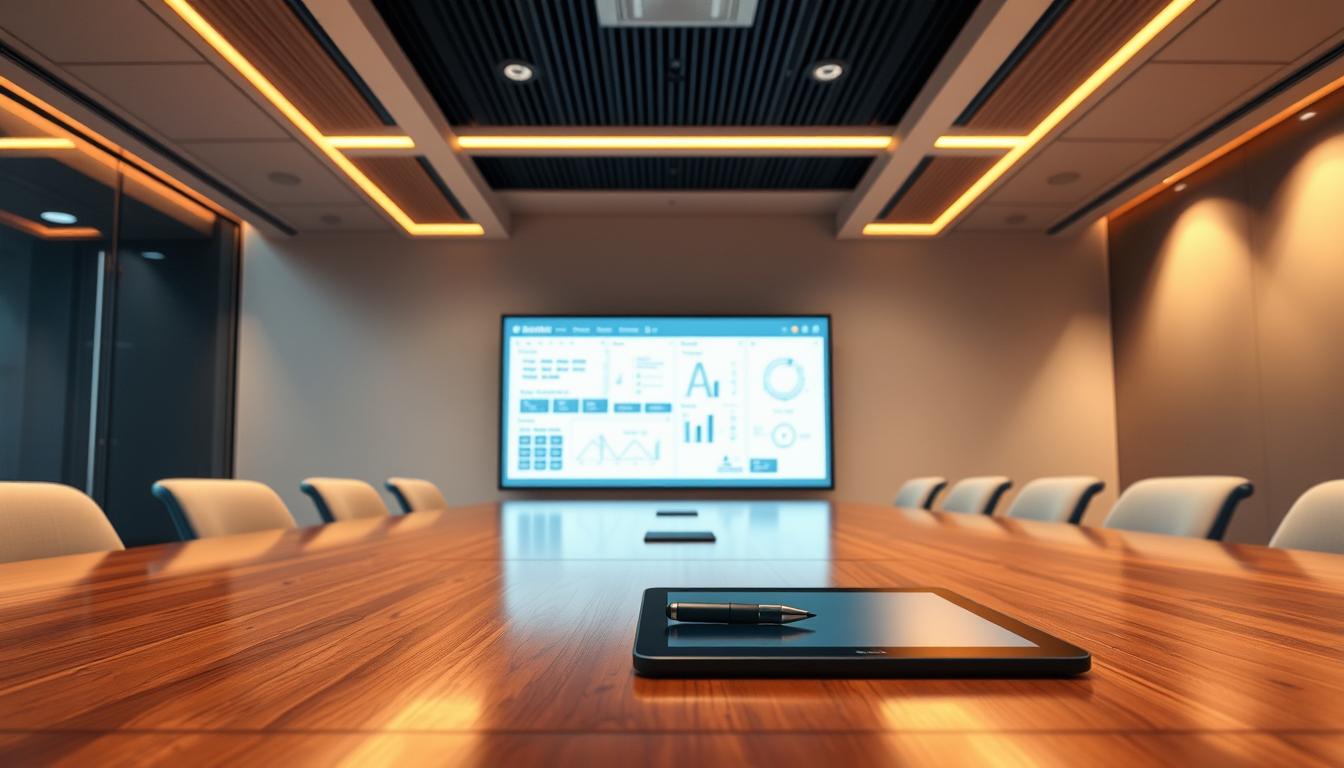What if your next meeting could capture every decision, action, and idea without anyone lifting a pen?
We believe modern meeting spaces should work for people, not against them. Smart displays like the Vibe Board S1 pair with Google Workspace, Microsoft 365, and Zoom to save and share content instantly.
By combining integrated video, microphones, and interactive boards, we create systems that record context and preserve intent. That means clear documentation for in-person and remote participants and smoother follow-up.
In this article, we map practical technology and solutions you can deploy room by room. We focus on capture quality, collaboration features, security, and the setup experience.
We aim to help you save time, reduce friction, and make meetings matter.
Key Takeaways
- Automated capture turns meetings into structured, searchable records.
- Integrated video and displays level the field for all participants.
- We evaluate tools by real deployment, not just specs.
- Choose stacks that tie directly to calendars and UC platforms.
- Success means faster capture, cleaner sharing, and better recall.
Why conference room notes digital matter in hybrid meetings
When hybrid meetings mix in-person and remote participants, capturing every idea becomes essential.
User intent: faster capture, cleaner sharing, better recall
We want meetings that record decisions without adding work. AI notetakers like Otter.ai and Microsoft Copilot transcribe, summarize, and extract action items live.
Integrated smart boards save annotations to the cloud so nothing is lost. That keeps files aligned with Microsoft 365 and Google Workspace calendars.
Key outcomes: accuracy, inclusivity for remote participants, and time savings
- Accuracy: Clear microphones and video improve speaker ID and action-item extraction.
- Inclusivity: Captions, transcripts, and persistent canvases help different work styles and remote participants stay engaged.
- Time savings: Faster capture reduces manual minutes, letting teams move from talk to execution.
We tie notes to invites and storage so artifacts live where you expect them—making follow-up simple and reliable.
How digital note-taking fits into modern meeting room technology
Dive into the signal chain and you see why capture quality starts with hardware. A well-framed camera and beamforming microphones feed cleaner inputs to AI assistants. That boosts speaker attribution and summary accuracy.
From cameras and microphones to whiteboards and AI assistants
We map the path from audio and video capture to transcription engines. Devices like Logitech Rally and Poly Studio X improve framing and noise suppression. Yealink adds acoustic shields for clearer pickup.
Interactive whiteboards — Cleartouch 6000A+ and Vibe Board S1 — let teams annotate, save, and link artifacts to storage instantly. Touch response and palm rejection matter for clean handwriting capture.
Integrations with Microsoft Teams, Google Workspace, and Zoom
Like Microsoft integrations, native apps and SSO keep files and recordings tied to the meeting. BYOD/BYOM modes let your software choices run while room-class audio and video feed the call.
“Proper setup—calibrated framing, echo control, and tested tools—turns meetings into reliable, actionable records.”
Evaluation criteria for product roundup selection
To choose systems that help teams, we test core capture and management workflows in live sessions. Quality matters at every step: mic pickup patterns, noise suppression, dereverberation, and how framing preserves context for accurate summaries.
Capture quality: audio pickup, camera framing, and whiteboard fidelity
We measure how well devices pick up speech and reject noise. Rally’s AI Viewfinder and Poly Studio X’s DirectorAI improve speaker framing for cleaner transcripts.
Whiteboard fidelity is scored on ink smoothness, handwriting conversion, and cloud save options — Cleartouch 6000A+ earns points for native Google app support.
Collaboration features: screen sharing, annotations, and simultaneous editing
We evaluate sharing reliability, annotation latency, and multi-user editing across platforms. Low latency and stable syncing are essential for productive meetings.
Management & security: SSO, admin controls, and encryption
Admin control, SSO, and encryption are non-negotiable. Mersive Solstice uses RSA-based encryption and PoE+, while Awaio delivers SSO and analytics for secure access and billing insights.
Setup experience: BYOD/BYOM, cabling, and hardware-light deployments
Ease of setup affects adoption. We score USB simplicity, cable management, and hardware-light options like QR-based booking. Good setup reduces friction for users and speeds rollout.
All-in-one room systems that enhance note capture and context
Converged systems remove guesswork from setup so your focus stays on the conversation.
We prefer turnkey bars and codecs because they lock together audio, video, and processing. That reduces variability in capture and improves transcript accuracy for all participants.

Logitech Rally Series
AI Viewfinder stabilizes framing while noise suppression filters distractions. The result: clearer transcripts and fewer missed action items.
Neat Bar
Presence detection wakes systems as people enter. Single-cable BYOD and dereverberation speed meeting starts and cut setup time.
Poly Studio X Series
DirectorAI tracks active speakers and preserves gallery layouts. Sizes from X52 to V52 map to small, midsize, and large rooms. Remote diagnostics aid IT support.
Yealink A Series
Conversation mode, picture-in-picture, and multi-focus framing keep distant participants visible. Acoustic shields focus mic pickup on table voices to limit false transcripts.
- Interoperability: native modes reduce PC dependence.
- Support: analytics and remote troubleshooting sustain consistent capture quality.
- Sizing: match models to room size to keep audio and camera fidelity for everyone.
Wireless presentation solutions that streamline screen sharing and annotated notes
Screen sharing should feel invisible—instant joins, clean displays, and no adapter hunting. We look at three systems that reduce setup time and make sharing and annotation simple for teams.
Barco ClickShare
ClickShare offers one-tap join and dual-screen support for Teams Rooms. That keeps remote video on one display and shared content on the other.
Why it helps: flexible networking (Ethernet, guest Wi‑Fi, device SSID) protects the core network while supporting visitors.
Kindermann K-FX
The K-FX supports up to four simultaneous shares and includes a built-in whiteboard. Teams can annotate live, snapshot outcomes, and use a digital signage mode between presentations.
Mersive Solstice
Solstice adds interactive pointers, ShareSwitch for hybrid flows, RSA encryption, PoE+, and dual HDMI outputs. Those features favor secure layouts and flexible display arrangements.
Be aware: we flagged audio/video sync issues and the need for a wired network in some deployments.
- Dongles and apps that enable instant screen sharing cut setup time at meeting start.
- Dual-screen modes separate remote video from shared content for clearer annotations.
- Built-in whiteboarding turns shares into living documents you can export.
- Encryption, PoE+, and dual HDMI matter for security, power, and layout flexibility.
Interactive displays and digital whiteboards purpose-built for meeting notes
The right display removes friction so teams focus on outcomes, not setup. We look at three leading interactive displays and how each supports faster capture, clearer content, and smoother collaboration.
Cleartouch 6000A+
4K clarity, EDLA certification for native Google apps, and up to 40 touch points make the Cleartouch ideal for fast brainstorming. Save canvases to OneDrive or Google Drive, use PiP to run parallel inputs, and manage devices via Google Admin Console for simpler IT control.
BenQ Board Pro RP04
BenQ pairs cloud whiteboarding with built-in mics that include noise suppression. Small teams can co-create remotely without extra hardware. The cloud sync keeps shared content current across locations.
Vibe Board S1
Vibe’s low-latency inking and tight integrations with Google Workspace, Microsoft 365, and Zoom let you annotate live video and save notes instantly to the cloud. Touch accuracy, palm rejection, and handwriting conversion improve legibility and downstream searchability.
- Save options: QR save, Drive/OneDrive sync, and PiP workflows.
- When to add gear: add external mics or speakers if you need transcription-ready audio for larger rooms.
AI-powered note-taking and transcription to automate the minutes
Live AI notetakers capture what people say, who said it, and what to do next—without slowing the meeting.
Otter.ai and Microsoft Copilot: live transcriptions, summaries, and action items
Otter.ai and Microsoft Copilot join sessions to transcribe speech, generate concise summaries, and extract action items moments after a meeting ends.
These assistants integrate with your calendar and meeting software so hosts can approve the assistant before it records. That keeps data handling transparent and auditable.
Speaker tracking + noise reduction: improving AI accuracy from the room up
Speaker tracking from systems like Poly Studio X improves attribution so task ownership lands with the right person. Beamforming mics and noise suppression from Neat and Logitech cut errors at the source.
We also recommend export paths to project boards and wikis to avoid retyping action lists. Admin controls and privacy settings must govern who can invoke the assistant and where transcripts live.
- How it works: the assistant joins, captures spoken content, and posts summaries.
- Accuracy: speaker tracking + dereverberation reduce cleanup time.
- Security: host approval, SSO, and scoped storage keep records safe.
Room scheduling and management that tie notes to the right meeting
Scheduling should do more than block a slot. It must link agendas, links, and files so everything lives with the right event.

We use Awaio to make booking simple and mobile-first. QR codes let people reserve a conference room with a scan, cutting hardware needs and speeding adoption across sites. SSO via Microsoft and Google keeps access secure and familiar.
Awaio: mobile-first bookings and analytics
Awaio offers flexible booking rules, utilization dashboards, and peak-hour reports. That data helps us right-size rooms and reallocate space where work really happens.
Calendar sync with Microsoft 365 and Google
Two-way sync means employees can book the correct meeting room from Outlook or Google Calendar. We attach links, files, and meeting artifacts to the calendar event so documentation travels with the invite.
- Reduce friction: QR bookings and interactive maps speed check-in.
- Keep schedules clean: timeouts and booking policies prevent collisions.
- Save IT time: embedded equipment guides cut support tickets and start meetings on time.
Designing the space: layout, lighting, and acoustics for better digital notes
A well-configured space turns good gear into reliable transcripts and readable whiteboards. We focus on simple layout moves that improve capture without complex installs.
Seating and camera angles for inclusive galleries and clear whiteboard views
Map seating to camera sightlines so every participant appears in the gallery and the whiteboard stays legible. Stagger chairs and keep sightlines unobstructed—this helps the 4K camera capture faces and handwriting equally well.
Microphones, echo control, and lighting for transcription-ready audio/video
Microphones: use beamforming mics and place them near the table center to cut crosstalk. That reduces missed phrases and improves speaker attribution.
Acoustics and audio: add acoustic panels or rugs to lower reverberation. Dereverberation plus noise-canceling mics yields cleaner transcripts.
Lighting and video: balanced lighting eliminates harsh shadows and glare that hide facial cues or obscure the display. Aim for even, front‑facing light and diffuse fixtures above the whiteboard.
- Match seating to sightlines so remote colleagues can read the display and see participants.
- Position microphones to avoid blocking views and to favor speech pickup.
- Test layouts with real recordings to validate capture quality before a full rollout.
We recommend trial runs with your typical meeting agenda and attendees. Small tweaks in layout, lighting, and mic placement often deliver the biggest jump in quality.
Implementation roadmap for U.S. teams
Begin with a focused pilot so you can tune technology for real meetings. We advise a staged setup that proves transcription accuracy, sharing stability, and calendar sync before scaling.
Pilot a small meeting space
Start with one managed room to validate AI transcription, wireless presentation reliability, and remote participant experience. Test Otter/Microsoft Copilot or your chosen software for speaker attribution and summary quality.
Check wireless systems: ClickShare supports corporate or guest Wi‑Fi and device SSID. Mersive requires wired networking—account for that in your cabling plan. Use PoE+ to reduce power runs.
Train for usability and accessibility
Create a short playbook: join steps, how to save whiteboard canvases, and where files land post-meeting. Train users on captions, voice commands, and inclusive hosting practices to improve adoption.
Security and networks
Define SSID policies, guest access rules, and PoE+ standards. Establish admin processes for firmware updates, remote diagnostics, and vendor support channels.
| Goal | Test | Success Metric |
|---|---|---|
| Transcription accuracy | Live AI + beamforming mics | ≥90% key phrase accuracy |
| Sharing reliability | ClickShare / wireless share | Instant join in <30 seconds |
| Operational readiness | Admin runbook & updates | Fewer IT tickets month-over-month |
- Measure outcomes: start time reliability, fewer IT tickets, transcript accuracy, and adoption rates.
- Iterate quickly: refine the setup and training before wider deployment.
conference room notes digital: building your best-fit stack
A pragmatic stack delivers solid capture, simple sharing, and predictable admin before you expand.
Starter stacks get you working fast. Pair Barco ClickShare or Kindermann for wireless screen sharing with Otter.ai or Microsoft Copilot for live transcription. Add Awaio to sync invites and files to Microsoft 365 or Google—so meeting artifacts land where teams already work.
Starter stack: wireless sharing + AI notes + calendar sync
What you get: fast joins, searchable transcripts, and calendar-linked storage. This low-friction setup uses proven tools to save time and reduce friction at meeting start.
Advanced stack: all-in-one bar + interactive display + admin analytics
Upgrade with a Poly, Neat, Logitech, or Yealink video bar plus a Cleartouch, BenQ, or Vibe interactive display. Add analytics from Awaio or device dashboards to measure utilization and quality.
Future-proofing: platform interoperability and scalable rooms
Plan for change: insist on Teams/Zoom/Google compatibility, BYOD/BYOM support, PoE+, and dual HDMI. Analytics will guide which rooms to scale first—prioritize high-use spaces and frequent external meetings.
“Start with the essentials, measure outcomes, then raise the bar where impact is proven.”
- Quick wins: wireless sharing + AI transcription = usable meeting records.
- Scale: add bars and interactive displays for higher fidelity capture.
- Standards: standardize cabling and management to simplify rollouts.
Conclusion
When tools work together, participants spend less time managing gear and more time deciding next steps. For hybrid meetings we recommend pairing all-in-one bars, wireless sharing, interactive displays, and AI assistants so outcomes are captured reliably for remote participants and in-person attendees.
Across conference and collaboration stacks, the right mix of cameras, microphones, and displays improves transcription accuracy and engagement. Wireless sharing and interactive whiteboards make content capture effortless, which lowers meeting overhead and speeds follow-up.
Start small: pilot one conference room with calendar sync and scheduling tools so artifacts attach to the correct invite. Measure accuracy, adoption, and cost, then scale. With interoperability and a staged roadmap, your rooms stay ready for any platform and any team—so work moves forward with clarity.

Leave a Reply